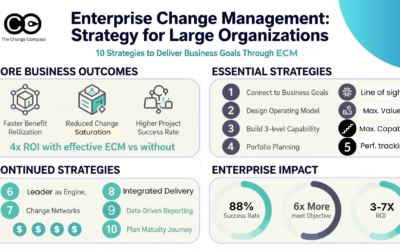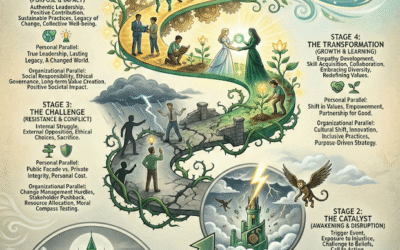Rethinking Change Champions Beyond the Project Lens
For decades, the change champion has been a familiar figure in large-scale transformation projects – the trusted liaison between the change team and the business, responsible for rallying colleagues, answering questions, and providing on-the-ground feedback.
But in most organisations, they are treated as short-term, disposable resources: assembled for a single initiative, tasked with helping during deployment, and then disbanded as soon as the project reaches steady state.
This project-by-project approach misses a critical opportunity.
Increasingly, forward-thinking organisations are moving towards an enterprise change champion model and treating these roles not as temporary assignments, but as a strategic, cross-project capability that sits at the heart of building a more change-resilient workforce.
Why the Traditional Change Champion Model Falls Short
The conventional change champion construct has obvious strengths:
- Champions are close to the ground, embedded in business units, and understand local challenges.
- They can translate change plans into the everyday realities of their teams.
- They give the project team early warning signs about resistance or readiness issues.
However, the limitations are equally apparent:
- Short-Term Focus – Once a deployment is complete, project change champions are often released without retaining the capability they’ve built.
- Loss of Internal Expertise – Any lessons learned, trust built, and skills acquired fade quickly when champions return to their ‘day jobs’ without a broader mandate.
- Fragmentation – Each project recruits, trains, and manages its own champions independently, leading to inconsistent standards and duplicated engagement with the same stakeholders.
- Missed Development Opportunities – Some of the most promising leaders remain untapped between projects.
When organisations experience continuous transformation with multiple overlapping initiatives, with varying scopes and impacts, this ad-hoc model leads to change fatigue and diluted influence.
A Step Change: The Enterprise-Wide Change Champion Network
What It Is
Instead of recruiting champions per project, the enterprise model creates a standing network of empowered, skilled employees and first-line managers who are trained, nurtured, and deployed to support any change in any part of the organisation.
They operate at two primary levels:
- Employee-level champions – embedded in day-to-day operations, they bring peer credibility and act as the first touchpoint for change comms and readiness checks.
- First-line manager champions – supervisory-level influencers who bridge the gap between leadership and frontline teams, actively managing the people side of change.
In addition, division-level representatives coordinate champion activity across their area and connect with the enterprise portfolio of changes. Some may sit in operational planning, HR, or directly in an enterprise change team, depending on organisational structure.
The Case for a Longer Term Champion Network
Change execution is not just about effective rollout – it’s about repeatable, scalable ability to change. The enterprise champion model delivers three key benefits that move the needle:
- Sustainable Capability – Skills in influencing without authority, creative engagement, and grassroots communication are retained in the organisation.
- Faster Time-to-Adoption – Champions already know the frameworks, templates, and rhythms of engagement, so each new change ramps up quickly.
- Talent Pipeline – Champions gain visibility, influencing opportunities, and leadership exposure, making them prime candidates for promotion into leadership, project, or change roles. Many organisations using this model have inadvertently built a ‘leadership incubator’ in the process.
Selecting the Right Champions: Intake Principles
Not every employee is suited to being a champion. The selection criteria are critical to ensuring the network is both high-performing and credible:
- Motivation – Champions must see value in playing the role, both intrinsically (desire to help the organisation evolve) and extrinsically (career growth, recognition).
- Communication Skills – Ability to translate technical or abstract change messages into plain language for peers.
- Coordination and Influence – Capable of corralling colleagues, keeping engagement high, and working across both formal reporting lines and informal networks.
The intake process should feel purposeful. This is not “volunteering” in the casual sense – it’s joining a professional network with enterprise significance.
Beyond Cheerleading: Shaping Change from the Ground Up
Traditional change champions too often become just “posters and cupcakes” – the enthusiastic promoters of a change, but with little voice in how it is planned or measured.
In the enterprise model, champions:
- Raise Awareness – in ways that are relevant to their teams and culture, rather than relying on corporate one-size-fits-all messaging.
- Sense-Check Readiness – gathering feedback and sentiment before key milestones, providing accurate insight back to project and leadership teams.
- Design Local Engagement – creating tailored activities that make the change tangible and exciting.
- Co-Own Measurement – participating in tracking adoption and readiness, and linking these to operational performance where relevant.
This measurement element is powerful. If champions see what is changing, when, and how much across the enterprise, they can better pace local adoption and avoid overwhelming their teams.
Now we turn to the how: the design, governance, and development practices that make an enterprise-wide change champion network a strategic business capability — trusted by leaders, respected by peers, and seen as a genuine driver of change adoption and organisational learning.
1. Designing the Enterprise Change Champion Model
A well-performing network of champions doesn’t rely on goodwill alone. It’s a deliberate, resourced capability with defined structure, integration points, and a clear operating rhythm.
a. Network Tiers
The most effective enterprise models feature three interconnected levels:
- Local Champions (Employee Level)
- Embedded within everyday operations.
- Directly influence peers through trust and credibility.
- Ensure changes are contextualised for their specific work environment.
- First-Line Manager Champions
- Serve as change role models for their teams.
- Help translate strategic initiatives into operational priorities.
- Manage workload balance between BAU and transformation demands.
- Divisional / Functional Representatives
- Coordinate local champions within their function or geography.
- Interface with enterprise-level change, HR, or operational planning teams.
- Escalate systemic adoption risks or barriers.
b. Integration with the Enterprise Operating Rhythm
Champions must be integrated into core business cycles, not treated as an “extra thing they do in their spare time”:
- Quarterly Business Reviews – Include updates on change readiness and adoption.
- Operational Meetings – Reserve time for upcoming change briefings.
- Annual Planning – Involve champions in pipeline awareness so they can pace change delivery for their teams.
This ensures the network’s role is embedded, not bolted on.
2. Governance: Balancing Structure with Flexibility
A champion network requires governance to maintain credibility, but too much rigidity can limit creativity and ownership. Senior practitioners should consider:
a. Clear Mandate
Document the network’s remit:
- To build and sustain readiness for change across the enterprise.
- To surface ground-level issues early.
- To contribute to measuring change adoption.
This clarity prevents champions from being used as “free event organisers” rather than strategic enablers.
b. Sponsorship
High-performing networks have active executive sponsorship, ideally within the executive team, ensuring:
- Visibility at the top table.
- Authority to escalate blockers.
- Access to resources.
c. Role Tenure and Rotation
- Typical tenure: 18–30 months, with renewal based on performance and availability.
- Regular rotation broadens exposure for more employees, refreshes energy in the network, and reduces burnout from continuous change advocacy.
3. Skills Development: Growing World-Class Change Advocates
An enterprise network will only be as strong as its learning and development program. Champions need more than “change updates” – they need targeted skill-building.
a. Core Skills Curriculum
- Influencing Without Authority – Building informal power and trust networks.
- Change Fundamentals – Understanding models, frameworks, and adoption levers.
- Storytelling for Change – Shaping narratives that inspire action.
- Sentiment Analysis – Gathering and interpreting feedback on readiness and concerns.
- Metrics Literacy – Understanding change dashboards and linking people data with performance outcomes.
b. Experiential Development
- Shadowing Project Teams – To understand the “engine room” of change delivery.
- Rotations Across Divisions – Cross-pollination of experience and approaches.
- Facilitating Workshops – Hands-on leadership of engagement activities.
c. Recognition and Career Pathways
If you want the best people to step forward as champions, you need to position it as a career accelerator:
- Formal credits in performance reviews.
- Priority consideration for emerging leadership or project roles.
- Public recognition in forums or internal comms.
4. Linking Champions to Change Metrics: Data as an Engagement Tool
One of the most powerful enablers of an enterprise champion network is visibility of change data– not just for executives, but for the champions themselves.
When champions can see:
- The enterprise change portfolio – what’s coming, when, and where.
- Impact heatmaps – the degree of change affecting each function.
- Adoption trends – progress metrics by region, team, or process.
…they can better inform their local teams, manage change saturation, and proactively address pockets of resistance.
Champion-Led Reporting Loops
- Champions provide local sentiment and engagement data back to the change and leadership teams.
- This creates two-way measurement, balancing top-down project metrics with authentic ground-level insight.
5. Sustaining Momentum Over Time
Even the most enthusiastic champion cohorts can lose energy without deliberate momentum-building mechanisms. Senior leaders can embed sustainability by:
- Regular Cohort Events – Quarterly summits to refresh skills, share success stories, and align on upcoming priorities.
- Recognition Rituals – Spotlighting champions who have made significant local impact.
- Knowledge Hubs – Digital platforms to share templates, tools, and peer insights.
- Graduation Paths – Allowing champions to “graduate” to advanced roles (e.g., mentoring new champions or stepping into change leadership roles).
Proving Impact, Embedding Talent Pipelines, and Cultivating a Change-Agile Culture
Previously we explored the rationale for shifting to an enterprise-wide change champion model and how to design, govern, and develop a high-performing network. Now we close the loop by focusing on how to demonstrate return on investment (ROI), embed the champion network into talent and leadership pipelines, and drive a culture where agility and change readiness are organisational norms.
1. Demonstrating the Strategic Impact and ROI of the Champion Network
Transformation leaders need to show tangible value to maintain investment in the champion model. This requires defining and tracking the right measures across multiple dimensions:
a. Change Adoption Metrics
- Speed to Adoption: Time taken for teams to reach defined levels of new process or tool usage.
- Adoption Volume: Percentage of the workforce actively using or complying with the change.
- Resistance Incidence: Frequency and severity of resistance signals identified via champions.
b. Employee Engagement and Sentiment
- Regular pulse surveys co-designed with champions to gauge readiness, concerns, and morale.
- Qualitative feedback from champions about barriers and enablers on the ground.
c. Talent Development Outcomes
- Promotion and role progression rates of change champions.
- Retention of champions compared to peer groups.
- Champion participation rates in subsequent change initiatives.
d. Business Performance Linkage
- Where possible, correlate change adoption rates with key performance indicators affected by the transformation (e.g., productivity improvement, customer satisfaction, error reduction).
The narrative around these metrics should highlight how the champion network reduces risk, accelerates change, and strengthens leadership pipelines—making it easier to secure ongoing support and resources.
2. Embedding the Champion Network into Talent and Leadership Pipelines
One of the most powerful aspects of an enterprise change champion model is its ability to develop future leaders through hands-on, cross-functional change experience:
a. Career Pathway Integration
- Define clear career pathways linking champion roles to leadership, project management, and change leadership positions.
- Include champion experience as a valued skill in performance appraisals and promotion criteria.
b. Succession and Rotation Planning
- Rotate champions through different business units and change projects to broaden their exposure.
- Use the network as a talent pipeline, actively identifying high-potential employees for targeted development.
c. Leadership Sponsorship and Mentorship
- Engage senior leaders as sponsors for champions, providing mentorship and visibility on strategic initiatives.
- Create mentorship programs pairing seasoned change professionals with champions to accelerate learning.
When treated seriously as a talent development program, the champion network becomes a leadership incubator that benefits the organisation far beyond the immediate change portfolio.
3. Cultivating a Change-Agile Culture through the Champion Model
Beyond skills and metrics, the enterprise champion model shapes an organisation’s cultural DNA by embedding change agility as a norm:
a. Peer Influence and Grassroots Advocacy
- Champions serve as trusted peers who normalize change discussions, reducing fear and uncertainty.
- Their ongoing active involvement signals to employees that change is continuous and manageable.
b. Building Collective Ownership
- Shared responsibility for success is fostered as champions co-own change outcomes with leadership and project teams.
- This prevents change being viewed as “something done to us” and instead as “something we drive together.”
c. Transparent Communication and Feedback Loops
- Regular updates from champions create a two-way dialogue between employees and leaders.
- Transparent sharing of data and progress builds trust and accountability.
d. Resilience and Adaptability
- The readiness and skills of champions help the organisation respond dynamically to shifting priorities and emerging challenges.
4. Case Study Insights: Organisations Leading with Enterprise Change Champions
Many organizations have reaped significant benefits from this approach:
- A global financial services firm reported a 30% faster adoption rate for technology transformations after establishing an enterprise champion network, alongside measurable improvements in employee engagement during change windows.
- A large insurer credits their champion network with preventing change fatigue across multiple simultaneous programs by pacing adoption and tailoring communications locally, thereby maintaining high service continuity.
These examples highlight that a well-designed enterprise champion model is more than a support function. It is a strategic enabler of organisational resilience and talent development.
Closing Thoughts
Building a sustainable enterprise change champion model requires commitment, structure, and investment. But the payoff is clear: an organisation equipped not only to execute change more effectively but to cultivate the next generation of leaders who understand change at a deep level.
By proving impact through metrics, integrating champions into career pathways, and cultivating a culture of collective ownership and agility, senior change and transformation practitioners can transform their organisations into change-ready powerhouses.
If you’re keen on setting up an enterprise change champion group powered by change data insights, reach out and chat to us.






